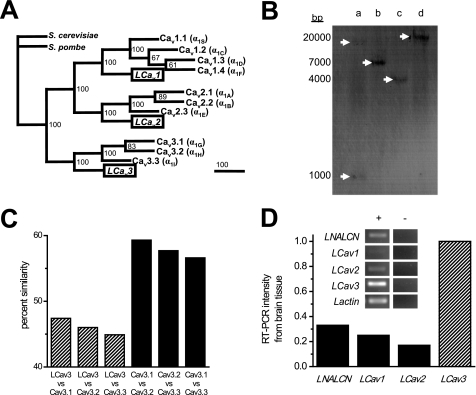FIGURE 2.
Singleton, snail T-type Ca2+ channel gene is distantly related to vertebrate homologs and is the most abundant Ca2+ channel transcript in the snail brain. A, shown is the most parsimonious gene tree generated using multiple aligned sequences, analyzed in PAUP4.0 (D. L. Swofford) and illustrated with TreeView (R. D. M. Page). Sequences include official human sequences (IUPHAR database); LCav3 (GenBankTM accession no. AF484084) and yeast gene Cch1 from Schizosaccharomyces pombe (GenBankTM accession no. CAB11726) and Saccharomyces cerevisiae (GenBankTM accession no. CAA97244). Numbers at branch points represent bootstrap values based on 100 replicates in heuristic search. Phylogram branches are scaled by their length and rooted with Cch1 Ca2+ channel homologs from fungi species. C, percent amino acid similarity scores were generated from EMBOSS NEEDLE (EMBL). B, Southern blot indicates a single copy gene in the Lymnaea genome. A T-type probe hybridized to create a banding pattern (white arrows) on the blot was created from membrane transfer of genomic DNA digested with either EcoRV(a), HindIII (b), EcoRI (c), or XhoI (d). The probe contained an EcoRV restriction site, so the probe hybridized to two genomic DNA fragments digested with EcoRV. D, densitometric intensity of RT-PCR bands (illustrated in the inset) was generated from Lymnaea brain tissue.

